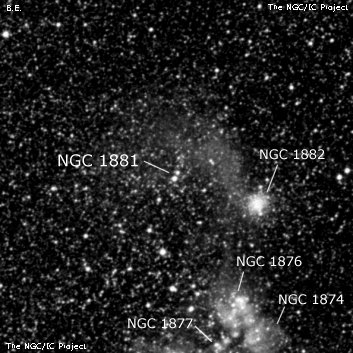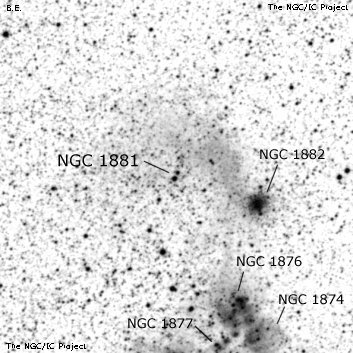NGC/IC Project Restoration Effort
(This is a very very beta version)
NGC1881


Basic Information
Location and Magnitude
Right Ascension: 5:13:36.0
Declination: -69:17:54
Constellation: DOR
Visual Magnitude:
Historic Information
Discoverer: Herschel J.
Year of discovery: 1838
Discovery aperture: 18.3
Observational
Summary description: vF, ** p
Sub-type: OCL
Corwin's Notes
=====
NGC 1881 is shown on JH's sketch that contains NGC 1874 (which see) and its
retinue of clusters and nebulae. Unlike the others, though, there are just a
few faint stars in the place of N1881, no more than an asterism. However,
JH's position (from the sketch) is exactly right for the group of faint stars,
as is his note of a double star preceding. There is a more obvious cluster
around that double star, however, so that is the object we have all taken in
the past.
Steve Gottlieb, during one of his recent Australian trips found, "a long,
curving chain of stars [that] extends to the NE of the N1874/76/77 complex and
ends at an easy pair of mag 12 stars [JH's double] that are located about 2.5'
NE of the globular N1872." Steve goes on to say in his email note, "But if
there is anything nebulous 'following' the double star, I didn't catch it --
only some weak haze surrounding the mag 12 stars." This was enough to lead
him to question the modern identification, and to lead me back to JH's sketch.
Steve's "curving chain of stars", by the way, is clearly visible on DSS just
as he describes it. It is also clearly shown in JH's sketch.
For now, I've left the modern position in the table, but have labeled it
"N1881 cl near **". As I noted, I've also confirmed JH's position. Here is
JH's complete description from CGH:
"vF; follows a double star. An outlier of the arc-formed nebula and cluster
[N1874/76/77]. Laid down in drawing Jan. 17, 1838, whence also its place.
See Plate III. fig. 6."
I think that this pretty well pins down the stars JH was looking at, but I'd
be happier if they were brighter and more obvious at the eyepiece. Well,
spending time sketching the field, he may have been able to pick out fainter
objects than we can see during a relatively quick survey. He certainly has
much faint diffused nebulosity shown around the field among the stars.
Steve's Notes
=====
NGC 1881
24" (4/5/08 - Magellan Observatory, Australia): a long, curving chain of stars (part of stellar association LH 35) extends to the NE of the NGC 1874/76/77 HII complex and ends at an easy pair of mag 12 stars (12" separation) located about 2.5' NE of the globular NGC 1872. At 260x, faint haze or unresolved stars, ~1' in diameter, encompasses this pair of stars.
Although there is dim nebulosity generally north and west of the double, John Herschel's description and sketch refers to an asterism of 5-6 faint stars 2.5' following the pair of stars. Modern sources are incorrect in identifying NGC 1881 with the pair of mag 12 stars.



